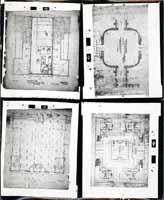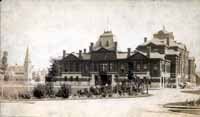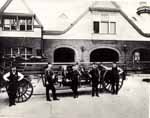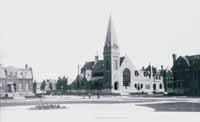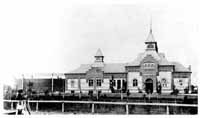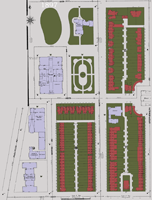Area Schools
You are at Home -> The Town of Pullman -> Area ChurchesPullman School

Public School, ca. 1890. |

The second Pullman school, 1917. |
A 1900 History of the Pullman School
To the pioneers of the Calumet region it seems but a short span to the time when Mr. Brennan and Mr. Martin were the only school teachers in this locality, where now something like 150 teachers are required to care for the army of children gathered in our schools. It was early in the year 1881 when the first families began to appear in the new houses of Pullman, and perhaps half a dozen children living in the Watt avenue block between 111th and 112th streets traveled across the prairie for the last three months of that school year to attend the old Kensington school, located where the Curtis branch now stands, and taught by Mr. Martin, now of the Pullman school. About this time the school authorities of Township No. 37 formed the new Pullman district, No. 11, by taking away from the Kensington and Roseland districts the land lying east of Indiana avenue, north of 115th street and south of 95th street. The first board of directors of this new school district were: Mr. Mead, assistant manager Pullman shops; Mr. E. W. Henricks, chief clerk, and Mr. Noah Van Winkle, first postmaster of Pullman. Nov. 21, 1881, Mr. Martin organized the Pullman school, assisted by Mrs. I. M. Biden, teacher, in the old Rock Island depot at Fulton and 111th streets. In January following, Miss Agnes Brennan, sister of the principal of the Van Vlissingen school, was added to the teaching force. The next year the population of Pullman had increased so rapidly that it was necessary to employ a force of twelve teachers. Among these teachers were Miss Lucy Selke, now a special teacher of drawing in the Chicago schools, and Miss Ada Johnson, a teacher of sewing at the present time. The freight depot, now occupied by the Hastings Express Co., and the old Market Hall were used for school purposes until February, 1883, when the new school building at Pullman avenue and 113th street was completed and occupied. The 105th street branch was opened during this year. In the fall of 1882 the school was placed under the direction of a board of education, of which Dr. John McLean was president, and E. C. Tourtelot was secretary. Both men held these offices until annexation, in 1889. In 1896 eight rooms were added to the school building. In 1902 the Riverside school was made a branch of the Pullman school, and in 1905 the Poe school was built to accommodate the children of North Pullman. The small children of this section had previously been poorly housed in branches, while the older children attended the main school. In the fall of 1907 the new twenty-six-room building was completed and occupied. This building has no superior in Chicago for elementary school purposes, and only awaits track elevation to be utilized to its limit for the purpose for which it was erected. The evening school has been a feature of the Pullman school since 1885 and has done a great work in this community, especially among the foreign population. The Pullman school has always had an efficient corps of teachers and has merited the confidence of the community which it has served. The present head assistant, Miss L. M. Vosburgh, Miss Dolton and Miss Helen Ferguson began service in 1883; Miss Ann Vosburgh in 1884; Miss MacDonald in 1886; Miss Mowbray in 1888, and Miss Fickell in 1889. Most of the other teachers have served from four to twelve years. Such permanency in the tenure of service of teachers counts much for the efficiency of the work of a school.Chicago Board of Education Proceedings, 1895-1896
Page 445: Proposition of George M. Pullman Accepted. A report of the committee that they had negotiated with George M. Pullman for several months past with reference to the leasing of the building and premises known as the Pullman School, and that they had, through the Chairman of the Committee, finally secured the following proposition, and recommending its acceptance by the Board, to-wit: Lease of the entire premises known as the Pullman School Building, located on Pullman and Morse avenues and One Hundred and Fourteenth street: lease to be made in the name of George M. Pullman; to date from September 1, 1895, and to expire August 31, 1898; rental, $7,500 per annum for the buildings and grounds; $1700 per annum for heating building, the Board of Education to keep said building in good repair.1887 GRADUATES
- Mary Canon
- Sidney Brilin (?)
- Ellen Johnson
- William Ball
- Rose Thompson
- Samuel Nilson
- Ida N--phir
- Maggie McQueen
- Annie Rafferty
Pullman Free School of Manual Training
At the time of his death, Pullman's estate was worth around $7,600,000. His will provided $1,200,000 for the establishment and endowment of an industrial school for children of people living in or employed by the Pullman Company. This school was built in 1915 and was known as the Pullman Free School of Manual Training (111th St. and King Drive). The cornerstone of the building was laid in 1914 and a year later the first class of 106 students started their training. This school was to be in operation until 1948. When the endowment was depleted, the school was purchased and operated by the Chicago Archdiocese until it became too much of a financial burden. It is now owned by the Chicago Public Schools and is called the Gwendolyn Brooks Academy.THE PULLMAN HISTORY SITE

More Information About the Town of Pullman
Planning the town
The Arcade Journal
The Hotel Florence
The Arcade
Arcade Park
The Stables
Market Hall
Area Churches
Area Schools
The Freight Depot and the Railway Station
Other Pullman Buildings
The Pullman House History Project

Arranged by:
Name
Address
Occupation
Birthplace
People of Color
Maps of Pullman
Images of the Town of Pullman
All images of the town
Vistas
Art & Architecture
- Landscape architect Nathan Franklin Barrett
- Architect Solon Spencer Beman
- Henry Koopman and Family, Photographer
- Landscape Design
Pullman’s Neighborhood
- The Calumet River
- IHACCR
- Area Churches
- The Kensington Neighborhood
- Lake Calumet
- North Pullman
- The Roseland Neighborhood
Buildings in Pullman
- The Arcade Building
- Arcade Park
- Carriage House
- Casino Building
- Fire Department
- Freight Depot
- Gas Works
- The Hotel Florence
- Hospital
- Houses
- Market Hall
- Schools
- Stable
- Train Station
Other Pullman-Related Sites
- Historic Pullman Garden Club - An all-volunteer group that are the current stewards of many of the public green spaces in Pullman. (http://www.hpgc.org/
- Historic Pullman Foundation - The HPF is a non-profit organization whose mission is to "facilitate the preservation and restoration of original structures within the Town of Pullman and to promote public awareness of the significance of Pullman as one of the nation's first planned industrial communities, now a designated City of Chicago, State of Illinois and National landmark district." (http://www.pullmanil.org/)
- The National A. Philip Randolph Pullman Porter Museum is a 501(c)3 cultural institution. Its purpose is to honor, preserving present and interpreting the legacy of A. Philip Randolph, Pullman Porters, the Brotherhood of Sleeping Car Porters and the contributions made by African-Americans to America's labor movement. ((http://www.nationalpullmanportermuseum.com/)
- Pullman Civic Organization - The PCO is a strong and vibrant Community Organization that has been in existence since 1960. (http://www.pullmancivic.org/)
- Pullman National Monument - The official page of the Pullman National Park. (https://www.nps.gov/pull/)
- South Suburban Genealogical & Historical Society - SSG&HS holds the Pullman Collection, consisting of personnel records from Pullman Car Works circa 1900-1949. There are approximately 200,000 individuals represented in the collection. (https://ssghs.org/)
- The Industrial Heritage Archives of Chicago's Calumet Region is an online museum of images that commemorates and celebrates the historic industries and workers of the region, made possible by a Library Services and Technology Act grant administered by the Illinois State Library. (http://www.pullman-museum.org/ihaccr/)
- Illinois Digital Archives (IDA) is a repository for the digital collections libraries and cultural institutions in the State of Illinois and the hosting service for the online images on this site. (http://www.idaillinois.org/)
